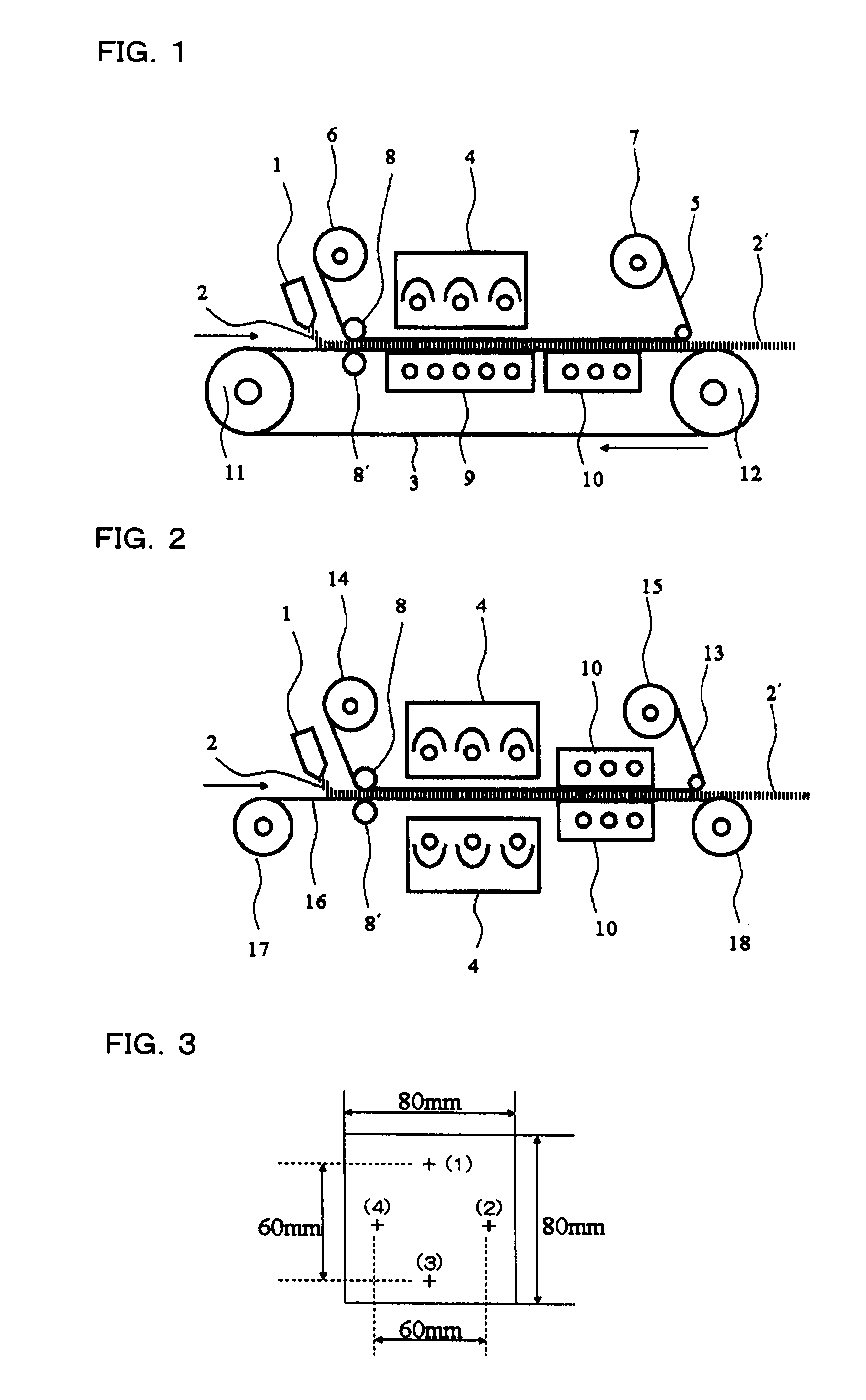Method for continuously producing acrylic resin sheet technical field
- Summary
- Abstract
- Description
- Claims
- Application Information
AI Technical Summary
Benefits of technology
Problems solved by technology
Method used
Image
Examples
example 1
[0171]To 60 parts of methyl methacrylate monomer, 0.3 part of 1-hydroxy-cyclohexylphenyl ketone (Irgacure 184 manufactured by Ciba Specialty Chemicals, Inc.) as an ultraviolet ray-decomposable polymerization initiator, and 0.05 part of sodium dioctylsulfosuccinate (Aerosol OT-100 manufactured by Mitsui-Cyanamid, Ltd.) as a release agent were added and dissolved at a normal temperature, and then 40 parts of methyl methacrylate polymer beads (BR-83 manufactured by Mitsubishi Rayon Co., Ltd.; having weight average molecular weight of 40,000) were dissolved therein by heating over the period of 30 minutes at 80° C., and thus an ultraviolet ray-polymerizable viscous liquid (polymer content being 39.9%) was prepared. The liquid was left to stand for 2 hours at 50° C. in order to remove foams formed at the time of preparation and then cooled to a normal temperature.
[0172]The same production system as shown in FIG. 1 was used, wherein a stainless steel endless belt having a width of 500 mm ...
example 2
[0175]The same procedure as in Example 1 was carried out except that 65 parts of methyl methacrylate monomer and 35 parts of methyl methacrylate polymer beads (BR-80 manufactured by Mitsubishi Rayon Co., Ltd.; having weight average molecular weight of 100,000) were used (polymer content being 34.9%), and a resin sheet was obtained. In this case, there were almost no thin parts even at the edges because the viscosity of the active energy ray-polymerizable viscous liquid was in a more preferable range of 10,000 mPa·s or more and thus drain at the edges was suppressed. The temperature peak in the section of ultraviolet ray irradiation was detected at 4.8 minutes after the start of the irradiation.
example 3
[0176]The same procedure as in Example 2 was carried out except that EGT-061-C1 manufactured by Eye Graphics Co., Ltd. was used as the ultraviolet ray-irradiation device and irradiation with the ultraviolet ray was carried out at 120 W / cm with an intensity of irradiation which corresponded to 2 J / cm2 in 0.5 minutes (an intensity of irradiation of 67 mW / cm2) for 6 minutes, and a resin sheet was obtained. In this case, detection of the temperature peak in the section of ultraviolet ray irradiation was shortened to 4.0 minutes, but a certain amount of yellowness was observed when the resin sheet was viewed from the edges because the intensity of irradiation of the ultraviolet ray was strong. The yellowness observed was not a serious level when the resin sheet was viewed from the surface and the resin sheet was good as a product.
PUM
| Property | Measurement | Unit |
|---|---|---|
| Temperature | aaaaa | aaaaa |
| Temperature | aaaaa | aaaaa |
| Temperature | aaaaa | aaaaa |
Abstract
Description
Claims
Application Information
 Login to View More
Login to View More - R&D
- Intellectual Property
- Life Sciences
- Materials
- Tech Scout
- Unparalleled Data Quality
- Higher Quality Content
- 60% Fewer Hallucinations
Browse by: Latest US Patents, China's latest patents, Technical Efficacy Thesaurus, Application Domain, Technology Topic, Popular Technical Reports.
© 2025 PatSnap. All rights reserved.Legal|Privacy policy|Modern Slavery Act Transparency Statement|Sitemap|About US| Contact US: help@patsnap.com

